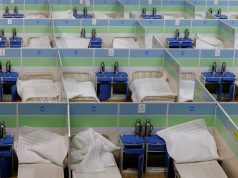
Tragic tales of COVID-19-infected patients who died outside hospital care present the grim impact of the worsening pandemic in the country.
In a Twitter thread on March 28, Angelo Barrera shared his family’s struggles in finding a hospital to treat their father who contracted the virus and later succumbed to the disease.
my dad died last night from COVID-19. I need you to understand that this is the government’s fault.#palpak #palpakduterte
he tested positive on March 16. we isolated him at home and got a doctor to monitor his vitals through text and prescribe medicine.
— ange (@ange_741_) March 28, 2021
His father was infected on March 16. His family managed to get a doctor to monitor him via text messaging and isolate him until the evening of March 27 when he started to experience difficulty in breathing.
They initially called for an ambulance, the Twitter user shared. However, they were asked for an upfront payment of P16,000 to P20,000.
“Instead we opted for a volunteer vehicle from a close friend. We were sustaining him through oxygen but the tank was nearly out,” he said.
Barrera then recounted their struggles of finding a hospital to admit him into the emergency room.
“We started shipping him to nearby hospitals and calling in advance. This was the worst part. Every. Single. Hospital. Every one of them was full. Be it admission, ER, even the waitlist for the ER. Every single one was full. You name it, from Asian Hospital to St. Luke’s,” he said.
At 3 a.m. on March 28, they finally got the father into the emergency room of South Superhighway Medical Center in Parañaque City.
The hospital’s intensive care unit, however, was already full.
Hours later, his father passed away outside the ER.
The situation is not unique to the family. Many others are bearing the brunt of the health crisis and weak healthcare system.
“I need you to understand that this is happening to so many people. EVERY hospital is full. Home care is the only option. Medical machines are in high demand and in low stocks. Access to emergency care is non-existent. How can I not blame the incompetence of the people leading us?” Barrera said.
A doctor at the hospital attested to Barrera’s story. She was among the doctors and staff who did their best to help his father.
“As a doctor, it frustrates me because we all know how to manage these patients. We’re here to give you our best care but we can only do so much these days because health workers are overworked, hospitals are full and our resources are depleting,” said the doctor named Anna Victorino on Twitter.
Some Reddit users also shared screenshots of posts with similar stories of their elderly relatives who died from COVID-19 but failed to get proper treatment due to the facilities’ full bed capacities.
Shared by a batchmate on FB. COVID suspect patient waiting in the driveway because the ER and Ward is full. Wear your mask. from Philippines
Hospitals’ COVID-19 bed capacity
In DOH’s COVID-19 tracker, as of Tuesday, more than 50% of ICU beds, isolation beds and ward beds in NCR had already been utilized.
The breakdown is:
- ICU beds – 76% utilized
- Isolation beds – 68% utilized
- Ward beds – 59% utilized
- Ventilators – 57% utilized
These figures translate to some of the largest hospitals in Metro Manila declaring full capacity due to the continuous rising COVID-19 cases.
These include St. Luke’s Medical Center in Taguig and Quezon City, The Medical City, Asian Hospital and Medical Center and the National Kidney and Transplant Institute.
Overall, 59% of ICU beds in the country are already being used. The rest of health care facilities in use are 46% of isolation beds, 45% of ward beds and 39% of ventilators.
Market surveillance analyst John Paul Tanyag also shared a screenshot of an Instagram story declaring another public hospital that reached full capacity.
No words. pic.twitter.com/8VRHn0eTg0
— Always Be My JP 🎶 (@dumidyeypee) March 29, 2021
On Wednesday, National Task Force against COVID-19 Medical Adviser Dr. Ted Herbosa said hospital capacity is “not yet on collapse.”
“Overcapacity na ang health capacity but nakaka-adjust pa naman,” he was quoted as saying at a Palace briefing.
RELATED: Non-COVID patients ‘collateral damage’ as hospitals get overwhelmed by coronavirus cases surge
Healthcare Professionals Alliance Against COVID-19 said the capacity of hospitals has always been struggling. The pandemic simply worsened its troubles.
Dr. Pauline Convocar, president of HPAAC-member Philippine College of Emergency Medicine, said that while tents were put up to extend emergency rooms and hospital beds would be added with a surge in patients since the onset of the coronavirus pandemic, the number of medical staff attending to patients hardly increased.
“We have to understand, hindi lang kasi ‘yun dapat beds so kailangan natin kasi bilangin din ‘yung healthcare workers na dapat nandun na nagmo-monitor ng beds na ito. Parating nawawala kasi sa usapan na kapag nagi-increase ka ng capacity, ibig sabihin lang ba nito magbubukas ka ng buong wing or buong floor? It’s not just as easy as that.”









